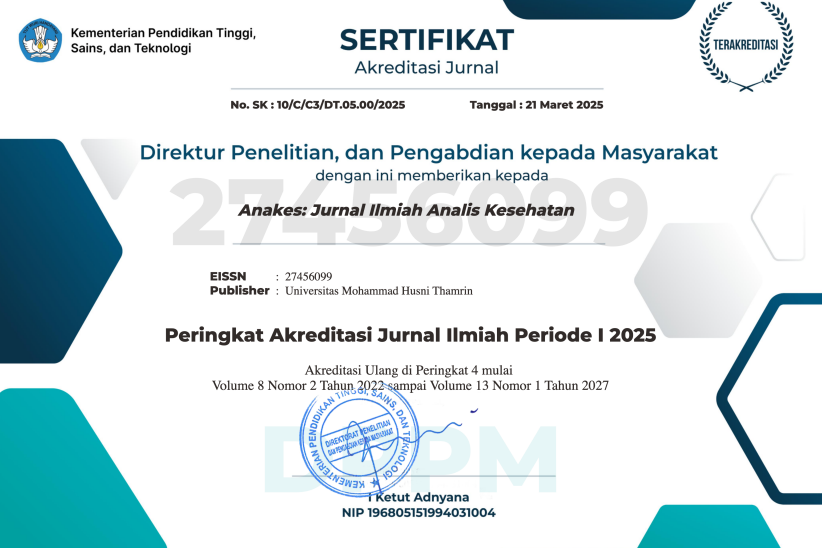Gambaran Morfologi Sel Neutrofil Pada Pewarnaan Giemsa dengan Variasi Waktu Pada Larutan Pengencer Akuades
DOI:
https://doi.org/10.37012/anakes.v10i1.1470Abstract
Giemsa staining is a microscopic staining technique that aims to identify the morphology of leukocyte cell types. One of the methods that uses giemsa staining is the method of examining peripheral blood smear preparations which aims to evaluate the calculation of leukocyte type. The dyeing quality of giemsa is greatly influenced by the type of diluent material, namely buffer and aquadest. This study aims to determine the morphological picture of neutrophil cells in giema staining with time variations in aquadest diluent solution. The method of this study was to take blood from adults aged 20-25 years and had no history of illness as many as 24 samples. It was divided into 2 dilution groups, namely pH buffer 6.8 and aquadest, where each dilution was divided into 4 groups, namely group 1 soaking the peripheral blood smear preparation for 10 minutes, group 2 soaking the peripheral blood smear preparation for 20 minutes, group 3 soaking the peripheral blood smear preparation for 30 minutes, group 4 soaking the peripheral blood smear preparation for 40 minutes. Then a qualitative analysis was carried out, namely by comparing the background of the preparation and the morphology of neutrophil cells microscopically in each group. The results of this study are that microscopically groups 1 and 2 have a clear preparation background, while in groups 3 and 4 the preparation background is dirty and there are neutrophil granules and morphology in groups 1 and 2 show dark blue neutropnhil cells, groups 3 and 4 show purple and bluish-purple neutrophil cells. The conclusion of this study is based on the background of the preparation, and the morphology of neutrophil cells, the group that has the best results is groups 1 and 2.
Key words : Aquadest, eosinophil cells, eutrophil cells, Giemsa staining
References
Aini, N. et al. 2023. Pewarnaan Sediaan Apusan Darah Tepi ( Sadt ) Menggunakan Infusa Bunga Telang ( Clitorea ternatea ) Pendahuluan Pemeriksaan apusan darah tepi merupak’ Jurnal Bina Cipta Husada Vol . XIX. pp. 67–76.
Bain, B. (2021) Blood cells: a practical guide. John Wiley & Sons, Ltd.
Darmadi; Darmawati, H. 2022. Perbedaan Hasil Pewarnaan Sediaan Apus Darah Tepi Menggunakan Buffer Fosfat pH 6,4 dan NaCl 0,9%’. Prosiding Asosiasi Institusi Pendidikan Tinggi Teknologi Laboratorium Medik Indonesia. pp. 120–126.
Irianto, K. (2013) Mikrobiologi : Menguak Dunia Mikroorganisme Jilid 1. Bandung: Yrama Widya.
Kiswari, R. (2014) Hematologi dan transfusi. Jakarta: Erlangga.
Nugraha, G. (2015) Panduan pemeriksaan laboratorium hematologi dasar. Jakarta: Trans Info Media.
Oktiyani, N. et al. (2022) ‘Utilization of Alternative Buffer Solutions for Staining Thin Blood smears by the Giemsa, Wright stain and Romanowsky method’, Tropical Health and Medical Research, 5(1), pp. 34–45.
Rahmad, A.P. (2011) Atlas Diagnostik Malaria. Jakarta: Kedokteran EGC.
Sari, A.N., Tazkiya, A. and Mafira, Y. (2020) ‘Ekstrak Air Bunga Kencana Ungu Sebagai Pewarnaan Alternatif Preparat Sediaan Apusan Darah Tepi’, Prosiding Seminar Nasional Biotik, 1(1), pp. 373–377.
Downloads
Published
How to Cite
Issue
Section
Citation Check
License
Copyright (c) 2024 Ahdiah Imroatul Muflihah

This work is licensed under a Creative Commons Attribution 4.0 International License.
Anakes :Â Jurnal Ilmiah Analis Kesehatan allows readers to read, download, copy, distribute, print, search, or link to the full texts of its articles and allow readers to use them for any other lawful purpose. The journal allows the author(s) to hold the copyright without restrictions. Finally, the journal allows the author(s) to retain publishing rights without restrictions Authors are allowed to archive their submitted article in an open access repository Authors are allowed to archive the final published article in an open access repository with an acknowledgment of its initial publication in this journal.

Lisensi Creative Commons Atribusi 4.0 Internasional.











